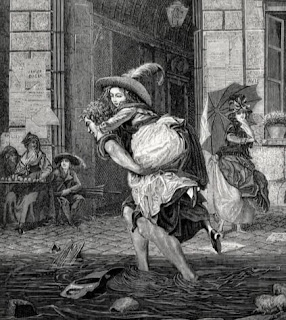Paris in the Middle Ages was not a sophisticated city; it was a city full of filth, disease, and uncleanness.
Urban Environment in Paris, France in the Middle Ages: A Messy and Unsanitary Era Paris, France, is widely regarded as one of the most beautiful and romantic cities in the world. However, it wasn't always the case. In the Middle Ages, Paris was a city filled with filth, disease, and squalor.
The city was overwhelmed by its rapidly growing population, and its infrastructure and sanitation systems were inadequate to handle the waste produced by the people. This article will explore the messy and unsanitary environment in Paris, France, during the Middle Ages, such as overflowing trash, throwing away corpses, and other unsanitary practices.
The Rapidly Growing Population in Paris
The population of Paris grew significantly during the Middle Ages, from around 20,000 in the 10th century to over 200,000 by the 14th century. The rapid growth in population led to overcrowding in the city and placed a great strain on its infrastructure and sanitation systems.
The Infrastructure and Sanitation Systems of Paris
In the Middle Ages, Paris had a rudimentary infrastructure and sanitation system. There were no proper sewage systems, and people threw their waste directly onto the streets. The streets were narrow and winding, making it difficult to transport goods and for people to move around. There were no public toilets, and people relieved themselves in the streets and alleyways.
Overwhelming Amount of Trash in Paris
With no proper waste disposal system in place, the streets of Paris were littered with trash. People threw their waste directly onto the streets, and the narrow alleyways and streets made it difficult for carts to remove the trash. This led to a buildup of waste, which attracted rats, vermin, and other disease-carrying animals.
Disposal of Corpses
In the Middle Ages, Parisians had a unique way of disposing of corpses. They would bury their dead in mass graves, which were often located near churches or in common burial grounds. However, when these burial sites became full, the corpses were dug up, and the bones were stacked in charnel houses. This led to a foul stench and the spread of disease.
Animal Waste and Other Sources of Pollution
Paris was home to many animals, including cows, horses, and pigs, which were kept in close quarters with people. Animal waste, along with other sources of pollution, such as tanneries, dyers, and other industries, added to the unsanitary conditions in the city.
Diseases and Illnesses in Paris
Due to the unsanitary conditions in Paris, disease and illness were rampant in the Middle Ages. The most common illnesses were the bubonic plague, cholera, typhoid, and tuberculosis. These diseases claimed the lives of thousands of Parisians each year.
Efforts to Improve the Urban Environment
Efforts to improve the urban environment in Paris began in the 12th century when the first sewer systems were built. The sewers were designed to carry waste away from the city and into the river. In the 13th century, the first public toilets were built, and regulations were put in place to prevent people from throwing waste onto the streets.
Urban Planning and DevelopmentIn the 14th century, King Charles V began a massive urban planning project that transformed the city. He ordered the streets to be widened and straightened, and new public spaces were created, such as the Place des Vosges. He also ordered the construction of new buildings, such as the Hôtel Saint-Pol, which still stands today.
The Evolution of the Urban Environment in Paris
Over time, the urban environment in Paris continued to evolve. In the 19th century, Baron Haussmann led another urban planning project that created the wide boulevards and parks that we know today. The infrastructure and sanitation systems were also greatly improved, with the construction of modern sewage systems and public sanitation facilities.
The Importance of Preserving the Urban Heritage of Paris
Despite the unsanitary conditions in Paris during the Middle Ages, the city's urban heritage is still an important part of its history and cultural identity. Many of the buildings and public spaces that were built during the Middle Ages still stand today, and they serve as a reminder of the city's rich history.
Conclusion
The urban environment in Paris during the Middle Ages was a messy and unsanitary era, overwhelmed by its rapidly growing population and inadequate infrastructure and sanitation systems. However, over time, efforts to improve the urban environment led to the creation of the beautiful city that we know today.
FAQs
Why was the urban environment in Paris so unsanitary during the Middle Ages?
The urban environment in Paris was unsanitary due to the rapidly growing population and inadequate infrastructure and sanitation systems.
What diseases were common in Paris during the Middle Ages?
The most common diseases were the bubonic plague, cholera, typhoid, and tuberculosis.
When did efforts to improve the urban environment in Paris begin?
Efforts to improve the urban environment in Paris began in the 12th century with the construction of the first sewer systems.
Who led the urban planning project in the 14th century?
King Charles V led the urban planning project in the 14th century.
Why is preserving the urban heritage of Paris important?
Preserving the urban heritage of Paris is important because it serves as a reminder of the city's rich history and cultural identity.
.jpg)
.jpg)
.jpg)
.jpg)
Comments
Post a Comment